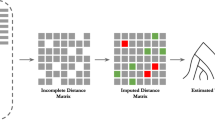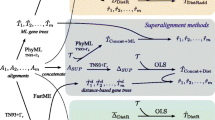Abstract
Evolutionary distances refer to the number of substitutions per site in two aligned nucleotide or amino acid sequences, which reflect divergence time and are much significant for phylogenetic inferences. In the past several decades, lots of molecular evolution models have been proposed for evolutionary distance estimation. Most of these models are designed under more or less assumptions and some assumptions are in good agreement with some real-world data but not all. To relax these assumptions and improve accuracies in evolutionary distance estimation, this paper proposes a framework containing Deep Neural Networks (DNNs), called DeepED (Deep learning method to estimate Evolutionary Distances), to estimate evolutionary distances for aligned DNA sequence pairs. The purposely designed structure in this framework enables it to handle long and variable length sequences as well as to find important segments in a sequence. The models of the network are trained with reliable data from real world which includes highly credible phylogenetic inferences. Experimental results demonstrate that DeepED models achieve a accuracy up to 0.98 (R-Squared), which outperforms traditional methods.
This work is partially supported by National Science Foundation of China (U1833114, 61872201, 61702521) and Science and Technology Development Plan of Tianjin (18ZXZNGX00140, 18ZXZNGX00200).
Z. Liu and M. Ren—These authors contributed equally to this work.
Access this chapter
Tax calculation will be finalised at checkout
Purchases are for personal use only
Similar content being viewed by others
References
Jukes, T.H., Cantor, C.R., et al.: Evolution of protein molecules. Mamm. Protein Metab. 3(21), 132 (1969)
Posada, D., Crandall, K.A.: Selecting the best-fit model of nucleotide substitution. Syst. Biol. 50(4), 580–601 (2001)
Cunningham, C.W., Zhu, H., Hillis, D.M.: Best-fit maximum-likelihood models for phylogenetic inference: empirical tests with known phylogenies. Evolution 52(4), 978–987 (1998)
LeCun, Y., Bengio, Y., Hinton, G.: Deep learning. Nature 521(7553), 436–444 (2015)
Xu, K., et al.: Show, attend and tell: neural image caption generation with visual attention. In: International Conference on Machine Learning, pp. 2048–2057 (2015)
Vaswani, A., et al.: Attention is all you need. In: Advances in Neural Information Processing Systems, pp. 5998–6008 (2017)
Tajima, F., Nei, M.: Estimation of evolutionary distance between nucleotide sequences. Mol. Biol. Evol. 1(3), 269–285 (1984)
Kimura, M.: A simple method for estimating evolutionary rates of base substitutions through comparative studies of nucleotide sequences. J. Mol. Evol. 16(2), 111–120 (1980)
Tamura, K.: Estimation of the number of nucleotide substitutions when there are strong transition-transversion and G+ C-content biases. Mol. Biol. Evol. 9(4), 678–687 (1992)
Waddell, P.J., Steel, M.A.: General time reversible distances with unequal rates across sites (1996)
Zhang, J., Xun, G.: Correlation between the substitution rate and rate variation among sites in protein evolution. Genetics 149(3), 1615–1625 (1998)
Simonyan, K., Zisserman, A.: Very deep convolutional networks for large-scale image recognition. arXiv preprint arXiv:1409.1556 (2014)
He, K., Zhang, X., Ren, S., Sun, J.: Deep residual learning for image recognition. In: Proceedings of the IEEE Conference on Computer Vision and Pattern Recognition, pp. 770–778 (2016)
Collobert, R., Weston, J.: A unified architecture for natural language processing: deep neural networks with multitask learning. In: Proceedings of the 25th International Conference on Machine Learning, pp. 160–167 (2008)
Devlin, J., Chang, M.W., Lee, K., Toutanova, K.: Bert: pre-training of deep bidirectional transformers for language understanding. arXiv preprint arXiv:1810.04805 (2018)
Hornik, K., Stinchcombe, M., White, H., et al.: Multilayer feedforward networks are universal approximators. Neural Netw. 2(5), 359–366 (1989)
Park, J., Sandberg, I.W.: Universal approximation using radial-basis-function networks. Neural Comput. 3(2), 246–257 (1991)
Zhang, H., et al.: A new method of RNA secondary structure prediction based on convolutional neural network and dynamic programming. Front. Genet. 10, 467 (2019)
Wang, R., et al.: Deepdna: a hybrid convolutional and recurrent neural network for compressing human mitochondrial genomes. In: 2018 IEEE International Conference on Bioinformatics and Biomedicine (BIBM), pp. 270–274. IEEE (2018)
Long, J., Shelhamer, E., Darrell, T.: Fully convolutional networks for semantic segmentation. In: Proceedings of the IEEE Conference on Computer Vision and Pattern Recognition, pp. 3431–3440 (2015)
Huber, P.J.: Robust estimation of a location parameter. In: Kotz, S., Johnson, N.L. (eds.) Breakthroughs in Statistics, pp. 492–518. Springer, New York (1992). https://doi.org/10.1007/978-1-4612-4380-9_35
Kingma, D.P., Ba, J.: Adam: a method for stochastic optimization. arXiv preprint arXiv:1412.6980 (2014)
Glorot, X., Bengio, Y.: Understanding the difficulty of training deep feedforward neural networks. In: Proceedings of the Thirteenth International Conference on Artificial Intelligence and Statistics, pp. 249–256 (2010)
Perelman, P., et al.: A molecular phylogeny of living primates. PLoS Genet. 7(3), e1001342 (2011)
Katoh, K., Standley, D.M.: MAFFT multiple sequence alignment software version 7: improvements in performance and usability. Mol. Biol. Evol. 30(4), 772–780 (2013)
Bouckaert, R., et al.: Beast 2: a software platform for Bayesian evolutionary analysis. PLoS Comput. Biol. 10(4), e1003537 (2014)
Hughes, L.C., et al.: Comprehensive phylogeny of ray-finned fishes (Actinopterygii) based on transcriptomic and genomic data. Proc. Natl. Acad. Sci. 115(24), 6249–6254 (2018)
Mirarab, S., Warnow, T.: ASTRAL-II: coalescent-based species tree estimation with many hundreds of taxa and thousands of genes. Bioinformatics 31(12), i44–i52 (2015)
Kumar, S., Stecher, G., Tamura, K.: Mega7: molecular evolutionary genetics analysis version 7.0 for bigger datasets. Mol. Biol. Evol. 33(7), 1870–1874 (2016)
Song, N., Liang, A.-P., Bu, C.-P.: A molecular phylogeny of hemiptera inferred from mitochondrial genome sequences. PLoS ONE 7(11), e48778 (2012)
Acknowledgements
This work is partially supported by National Science Foundation of China (61872201, 61702521, U1833114) and Science and Technology Development Plan of Tianjin (18ZXZNGX00140, 18ZXZNGX00200).
Author information
Authors and Affiliations
Corresponding authors
Editor information
Editors and Affiliations
Rights and permissions
Copyright information
© 2020 Springer Nature Switzerland AG
About this paper
Cite this paper
Liu, Z., Ren, M., Niu, Z., Wang, G., Liu, X. (2020). DeepED: A Deep Learning Framework for Estimating Evolutionary Distances. In: Farkaš, I., Masulli, P., Wermter, S. (eds) Artificial Neural Networks and Machine Learning – ICANN 2020. ICANN 2020. Lecture Notes in Computer Science(), vol 12396. Springer, Cham. https://doi.org/10.1007/978-3-030-61609-0_26
Download citation
DOI: https://doi.org/10.1007/978-3-030-61609-0_26
Published:
Publisher Name: Springer, Cham
Print ISBN: 978-3-030-61608-3
Online ISBN: 978-3-030-61609-0
eBook Packages: Computer ScienceComputer Science (R0)




